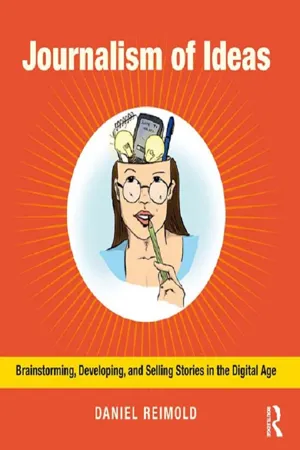
Journalism of Ideas
Brainstorming, Developing, and Selling Stories in the Digital Age
- 368 pages
- English
- ePUB (mobile friendly)
- Available on iOS & Android
About this book
Journalism of Ideas is a comprehensive field guide for brainstorming, discovering, reporting, digitizing, and pitching news, opinion, and feature stories within journalism 2.0. With on-the-job advice from professional journalists, activities to sharpen your multimedia reporting skills, and dozens of story ideas ripe for adaptation, Dan Reimold helps you develop the journalistic know-how that will set you apart at your campus media outlet and beyond.
The exercises, observations, anecdotes, and tips in this book cover every stage of the story planning and development process, including how news judgment, multimedia engagement, records and archival searches, and various observational techniques can take your reporting to the next level. Separate advice focuses on the storytelling methods involved in data journalism, photojournalism, crime reporting, investigative journalism, and commentary writing. In addition to these tricks of the trade, Journalism of Ideas features an extensive set of newsworthy, timely, and unorthodox story ideas to jumpstart your creativity. The conversation continues on the author's blog, College Media Matters.
Reimold also shows students how to successfully launch a career in journalism: the ins and outs of pitching stories, getting your work published, and navigating the post-graduation job search. Related sections of the book highlight the art of freelancing 2.0, starting an independent site, blogging, constructing quality online portfolios, securing internships, and building a social media following.
Frequently asked questions
- Essential is ideal for learners and professionals who enjoy exploring a wide range of subjects. Access the Essential Library with 800,000+ trusted titles and best-sellers across business, personal growth, and the humanities. Includes unlimited reading time and Standard Read Aloud voice.
- Complete: Perfect for advanced learners and researchers needing full, unrestricted access. Unlock 1.4M+ books across hundreds of subjects, including academic and specialized titles. The Complete Plan also includes advanced features like Premium Read Aloud and Research Assistant.
Please note we cannot support devices running on iOS 13 and Android 7 or earlier. Learn more about using the app.
Information
The Idea Stage

“I saw stories everywhere. At dinner parties, I would leave with two or three story ideas. Every phone conversation, every movie or play, every walk down the street or trip on the subway brimmed with possibilities. I wrote down every idea that occurred to me, on scraps of paper that I stuffed into my jacket pockets. When I arrived at the office, I would empty my overflowing pockets and sort through the scraps.”Arthur Gelb, former New York Times managing editor,
reflecting on his days as deputy metro editor
■ Over the past decade, digital tools and platforms have rocketed journalism to a universe of innovation, interactivity, and immediacy once unimaginable. Yet, without stellar content, journalism 2.0 is not worth the effort to read, watch, listen, contribute to, or connect with. Everything journalism was, is, and will be rests on our ability to tell a story. And every story starts with an idea.
WOW STORIES

“Reporters should learn from the get-go that uncovering story ideas is their job. Any editor worth his or her salt will make it clear that reporters who have no story ideas will not be reporters for long.”Doug Cabral, editor, The Martha's Vineyard Times, Mass.
“Ideas are your currency, so always be pitching them, researching them, and refining them.”Robert Terry, managing editor, Washington Business Journal, D.C.
PUBLISHED GOLD
Table of contents
- Cover
- Half Title
- Title Page
- Copyright Page
- Dedication
- Table of Contents
- Acknowledgements
- Chapter 1 The Idea Stage
- Chapter 2 A Journalism Life
- Chapter 3 People Stories
- Chapter 4 Fresh Perspectives
- Chapter 5 Words, Letters, and Lots of Ideas
- Chapter 6 Timely Ideas
- Chapter 7 Trendy Ideas
- Chapter 8 Criminal Ideas
- Chapter 9 Location, Location, Location
- Chapter 10 The Local Angle
- Chapter 11 Building a Beat
- Chapter 12 Records Reporting
- Chapter 13 Data Journalism
- Chapter 14 Photojournalism Ideas
- Chapter 15 An Immersion of Ideas
- Chapter 16 Idea Lists
- Chapter 17 Digital and Mobile Story Mining
- Chapter 18 Journalism Hackathon
- Chapter 19 Field Notes
- Chapter 20 The Sales Pitch
- Conclusion Rebellious Reporter Child
- Bibliography
- Index